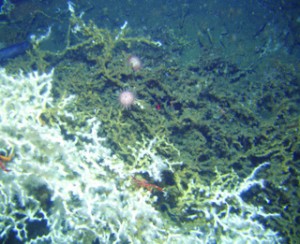Andrew J. Davies, Gerard C.A. Duineveld, Tjeerd C.E. van Weering, Furu Mienis, Andrea M. Quattrini, Harvey E. Seim, John M. Bane and Steve W. Ross

The Lophelia pertusa community at Viosca Knoll (VK826) is the most extensive found to date in the Gulf of Mexico. As part of a multi-disciplinary study, the physical setting of this area was described using benthic landers, CTD transects and remotely operated vehicle observations. The site was broadly characterised into three main habitats: (1) dense coral cover that resembles biogenic reef complexes, (2) areas of sediment, and (3) authigenic carbonate blocks with sparse coral and chemosynthetic communities. The coral communities were dominated by L. pertusa but also contained numerous solitary coral species. Over areas that contained L. pertusa, the environmental conditions recorded were similar to those associated with communities in the north-eastern Atlantic, with temperature (8.5–10.6 °C) and salinity (ca. 35) falling within the known species niche for L. pertusa. However, dissolved oxygen concentrations (2.7–2.8 ml l−1) and density (σΘ, 27.1–27.2 kg m−3) were lower and mass fluxes from sediment trap data appeared much higher (4002–4192 mg m−2 d−1). Yet, this species still appears to thrive in this region, suggesting that L. pertusa may not be as limited by lower dissolved oxygen concentrations as previously thought. The VK826 site experienced sustained eastward water flow of 10–30 cm s−1 over the 5-day measurement period but was also subjected to significant short-term variability in current velocity and direction. In addition, two processes were observed that caused variability in salinity and temperature; the first was consistent with internal waves that caused temperature variations of 0.8 °C over 5–11 h periods. The second was high-frequency variability (20–30 min periods) in temperature recorded only at the ALBEX site. A further pattern observed over the coral habitat was the presence of a 24 h diel vertical migration of zooplankton that may form part of a food chain that eventually reaches the corals. The majority of detailed studies concerning local environmental conditions in L. pertusa habitats have been conducted within the north-eastern Atlantic, limiting most knowledge of the niche of this species to a single part of an ocean basin. Data presented here show that the corals at VK826 are subjected to similar conditions in temperature, salinity, and flow velocity as their counterparts in the north-east Atlantic, although values for dissolved oxygen and density (sigma-theta: σΘ) are different. Our data also highlight novel observations of short-term environmental variability in cold-water coral habitat.
Published in Deep Sea Research vol one 57.
Request PDF
| To request a PDF copy of this paper, please enter your email address below: Your email address is not stored, it is only used to send an email with an attached PDF to you. |
Full Citation
Davies, A.J., Duineveld, G.C.A., van Weering, T.C.E., Mienis, F., Quattrini, A.M., Seim, H.E., Bane, J.M. & Ross, S.W. (2010) “Short-term environmental variability in cold-water coral habitat at Viosca Knoll, Gulf of Mexico.” Deep-sea Research Vol 1. 57(2): 199-212.
